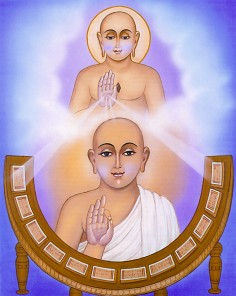
Final colophon of Uttarādhyayana Sūtra
Introduction
About the work translated in this volume, the Uttarādhyayana, I have little to add to the remarks of Professor Weber in the Indische Studien, vol. xvi, p. 259 ff., and vol. xvii, p. 43 ff. The Uttarādhyayana, the first Mūlasūtra, belongs to the last section of the Siddhānta. Its intention is to instruct a young monk in his principal duties, to commend an ascetic life by precepts and examples, to warn him against the dangers in his spiritual career, and to give some theoretical information. The heretical doctrines [as found in works such as the Sūtrakṛtāṅga] are only occasionally alluded to, not fully discussed; apparently the dangers expected from that quarter grew less in the same measure as time advanced and the institutions of the sect were more firmly established. Of more importance to a young monk seems to have been an accurate knowledge of animate and inanimate things, as a rather long treatise on this subject has been added at the end of the book.
Though there is an apparent plan in the selection and arrangement of the single Lectures, still it is open to doubt whether they were all composed by one author, or only selected from the traditional literature, written or oral, which among the Jainas, as everywhere else, must have preceded the formation of a canon. I am inclined to adopt the latter alternative, because there is a greater variety of treatment and style in the different parts than seems compatible with the supposition of one author, and because a similar origin must be assumed for many works of the present canon.
At what time the works under discussion were composed or brought into their present shape is a problem which cannot be satisfactorily solved. As, however, the reader of the present volume will naturally expect the translator to give expression to his personal conviction on this point, I give my opinion with all reserve, viz. that most parts, tracts, or treatises of which the canonical books consist, are old; that the redaction of the Angās took place at an early period (tradition places it under Bhadrabāhu); that the other works of the Siddhānta were collected in course of time, probably in the first centuries before our era, and that additions or alterations may have been made in the canonical works till the time of their first edition under Devardhigaṇin (980 A.V. = 454 A.D.)
I have based my translation of the Uttarādhyayana on the text adopted by the oldest commentators I could consult. This text differs little from that of the MSS. and the printed editions. I had prepared a text of my own from some MSS. at my disposal, and this has served to check the printed text.
The Calcutta edition of the Uttarādhyayana (Saṃvat 1936 = 1879 A.D.) contains, besides a Guzeratī gloss, the Sūtradīpikā of Lakṣmīvallabha, pupil of Lakṣmīkīrtigaṇin of the Kharatara Gaccha. Older than this commentary is the Tīkā of Dēvēndra, which I have made my principal guide. It was composed in Saṃvat 1179 or 1123 A.D., and is confessedly an abstract from Śāntyāchārya’s Vṛtti, which I have not used. But I have had at my disposal an illuminated old MS. of the Avachūri, belonging to the Strassburg University Library. This work is apparently an abstract from the Vṛtti of Śāntyāchārya, as in a great many passages it almost verbally agrees with Dēvēndra’s work.
Hermann Jacobi
Bonn, November, 1894.
Additional Note.I may here add a remark on the Parable of the Three Merchants [see the seventh lecture], which agrees with Matthew 15:14 and Luke 14:11. It seems, however, to have had a still greater resemblance to the version of the parable in The Gospel according to the Hebrews, as will appear from the following passage from Eusebius’ Theophania (ed. Migne’s Patrologia Graeca, iv. 155), translated by Nicholson:
“The Gospel according to the Hebrews (London, 1879): The Gospel, which comes to us in Hebrew characters, has directed the threat not against the hider, but against the abandoned liver. For it has included three servants, one which devoured the substance with harlots and flute-women, one which multiplied, and one which hid the talent: one was accepted, one only blamed, and one ṣut up in prison.”
I owe this quotation to my colleague Arnold Meyer.
Taking into consideration (1) that the Jaina version contains only the essential elements of the parable, which in the Gospels are developed into a full story; and (2) that it is expressly stated in the Uttarādhyayana VII:15 that “this parable is taken from common life,” I think it probable that the Parable of the Three Merchants was invented in India, and not in Palestine.
H. J.
 Ganadhar Sudharma Swami
Ganadhar Sudharma Swami
